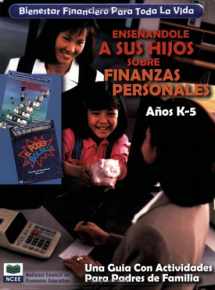
Financial Fitness for Life: Parent's Guide K-5 Spanish (Financial Fitness for Life) (Spanish Edition)
ISBN-13:
9781561835393
ISBN-10:
1561835390
Author:
Mark C. Schug, Martha C. Hopkins, Donna K. Wright
Publication date:
2005
Publisher:
National Council on Economic Education
Format:
Paperback
160 pages
FREE US shipping
Book details
ISBN-13:
9781561835393
ISBN-10:
1561835390
Author:
Mark C. Schug, Martha C. Hopkins, Donna K. Wright
Publication date:
2005
Publisher:
National Council on Economic Education
Format:
Paperback
160 pages
Summary
Financial Fitness for Life: Parent's Guide K-5 Spanish (Financial Fitness for Life) (Spanish Edition) (ISBN-13: 9781561835393 and ISBN-10: 1561835390), written by authors
Mark C. Schug, Martha C. Hopkins, Donna K. Wright, was published by National Council on Economic Education in 2005.
With an overall rating of 3.7 stars, it's a notable title among other
books. You can easily purchase or rent Financial Fitness for Life: Parent's Guide K-5 Spanish (Financial Fitness for Life) (Spanish Edition) (Paperback) from BooksRun,
along with many other new and used
books
and textbooks.
And, if you're looking to sell your copy, our current buyback offer is $0.3.
Description
The Financial Fitness for Life Curriculum consists of high-quality materials that assist students from kindergarten to grade twelve in making better decisions for earning income, spending, saving, borrowing, investing, and managing their money. The materials at the four levels (grades K-2, 3-5, 6-8, and 9-12) focus on a fitness theme. Developing financial fitness is like developing physical fitness. Both require first developing a knowledge base and then applying it. The development of knowledge and the use of that knowledge in the everyday life of the students is an integral part of the individual lessons. Each level uses fitness terminology. The headings for the different parts of the lessons include Equipment (materials needed), Warm-Up (introduction to lesson), Workout (body of lesson), and Cool Down (summary and review). Another analogous concept, which is stressed in the materials, is that one must continually work on financial fitness, because of new developments. The materials emphasize that there are some basic routines that are used in order to maintain financial fitness, such as the importance of determining the cost of each choice and the realization that there is no free lunch. Besides the fitness focus, there are other common features to all of the levels. They include: 1. Each set of materials is based on national standards. Matrices showing how the materials relate to national language arts and mathematics are provided in the opening pages of the K-2 and 3-5 grade level documents. Matrices also show how each lesson relates to the national standards for economics and the national standards for personal finance. 2. All materials employ economics, called the science of decision making, as a way to prioritize the staggering array of choices facing students when they make decisions. By prioritizing, students learn how to make better decisions, and, equally important, to avoid poor ones. The emphasis on using economic concepts and an economic way of thinking distinguishes these materials from other materials used to develop personal financial literacy. The economic concepts and economic ways of thinking are basic fitness routines used when a person deals with personal financial matters. 3. Active learning and student reflection on these activities dominate all materials. Active learning without reflection does not necessarily enhance true learning defined as changing behavior. Active learning plus reflection optimizes true learning. As with physical fitness, one must '“do' and then 'reflect' upon what one did in order to incorporate that learning into one'’s style. 4. Developing physical fitness involves doing a variety of exercises and varying those exercises over time. Similarly, these materials include a variety of methods that appeal to many different learning styles. Role playing, group discussions, gathering information from the internet, reading materials, interviewing individuals, drawing pictures, and analyzing case problems are some of the many teaching methods that are found in the materials. Even more materials are available on the web site of the National Council on Economic Education that can add to the repertoire of activities and materials available to develop financial fitness. 5. A number of influential coaches can enhance the fitness process, especially when developing financial fitness. Parent’s as partners in the educational process are an integral part of this set of materials. Parents play an important role in developing the personal financial literacy of their children because of the modeling that they do in everyday life. The lesson plans for each educational level have a parent guide, which provides background information and fun activities for both the parent and child. 6. Similar to planning physical fitness activities for different ages, the economic and personal


We would LOVE it if you could help us and other readers by reviewing the book
Book review

Congratulations! We have received your book review.
{user}
{createdAt}
by {truncated_author}


